The Bavette steak may be lesser-known, but this flap steak has a lovely tender texture when marinaded and cooked quickly in a cast-iron skillet (or grilled). If you enjoy flank steak, skirt steak, or hanger steaks then you are going to love this recipe!
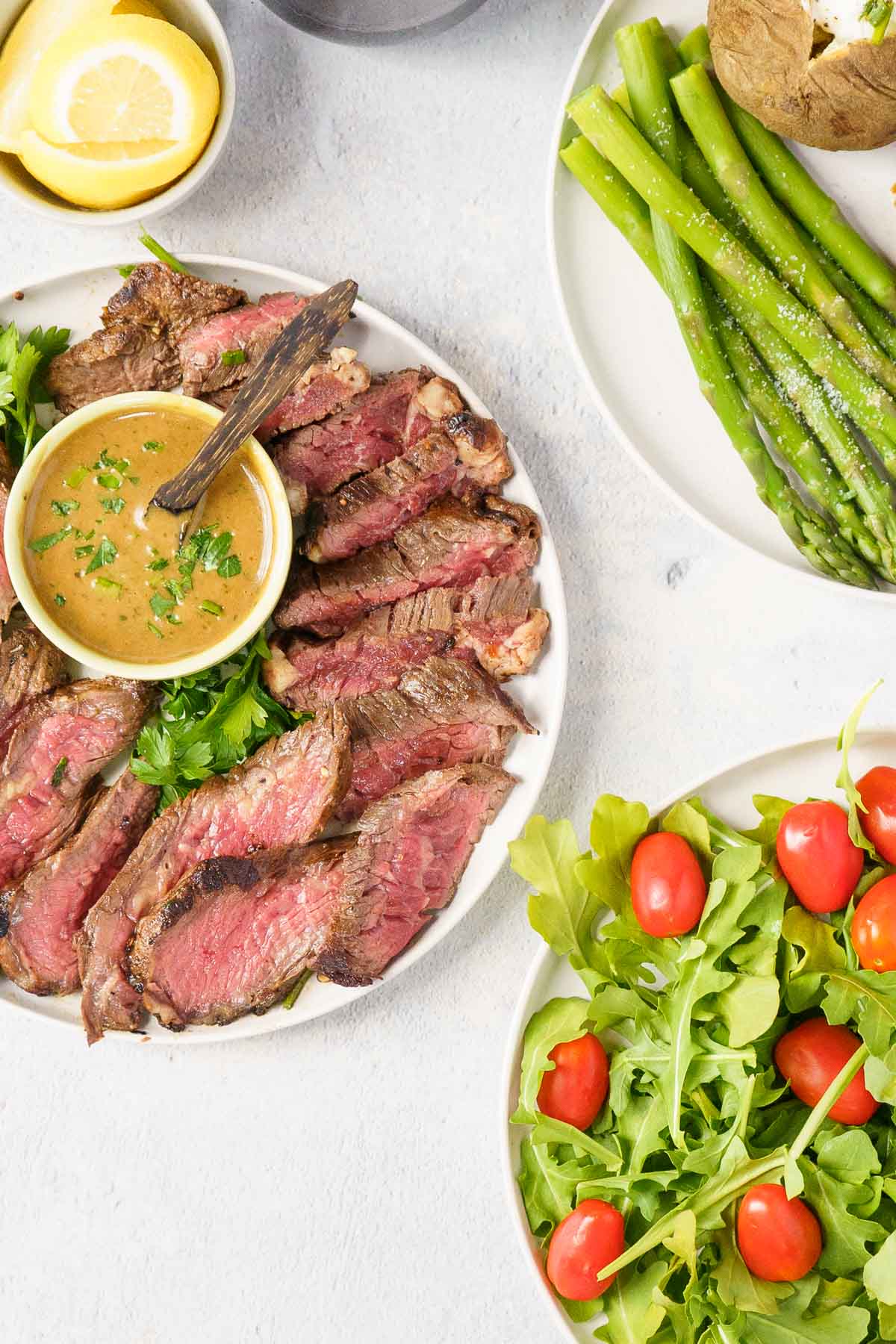
This post may include affiliate links. Please read my disclosure policy.
Bavette steaks have been making a comeback as of late. Often called a butcher's cut, because the butcher would save back this piece of the sirloin for themselves, bavettes may not be as popular as a New York strip or a filet mignon but they are big on flavor.
While we are preparing this specific bavette with a balsamic marinade, you can really use any of your favorite steak marinades or sauces, like our spectacular chimichurri, the best wild ramp pesto when you're feeling fancy, add a dry rub similar to our flank steak, or keep it simple and top with a compound butter with herbs or simple pan sauce.
Jump to:
🥩What is a Bavette Steak?
Bavette is the french word for bib. A bavette steak comes from the bottom flap of the sirloin section and is often called a sirloin flap steak.
It is a thin steak with a fine texture best seared in a cast iron pan or grilled. In the US, it is often mistaken for a flank steak, which comes from the cow's abdomen and looks similar, which ironically is also a bib steak.
Bavette steaks are best when marinated and either quickly seared in a cast-iron skillet or grilled at a high temperature. Cook until your desired doneness. Although above medium is not recommended.
Why This Recipe Works
Flap steaks, like a bavette, benefit from a tenderizing marinade or rub. Our marinade is made with pantry staples for a quick and easy weeknight dinner.
We cook the steak quickly at a high temperature to achieve a crispy crust and a tender interior.
This bavette steak recipe is juicy and approachable steak. Bavette steak comes from the sirloin, making it more affordable than premium steak cuts but with all the flavor steak lovers expect.
🧾Ingredient Notes
Bavette steaks are found most often at your local butcher shop, Wagyu beef farms (yes, Wagyu Bavette steak is totally a thing), and mail order services like Butcher Box. I rarely find a bavette cut at the grocery store. But if you can, it is a great option for an inexpensive and delicious cut of meat.
Note: If you want to try a Wagyu Bavette we recommend Snake River Farms. It will have more marbling than a traditional beef bavette.
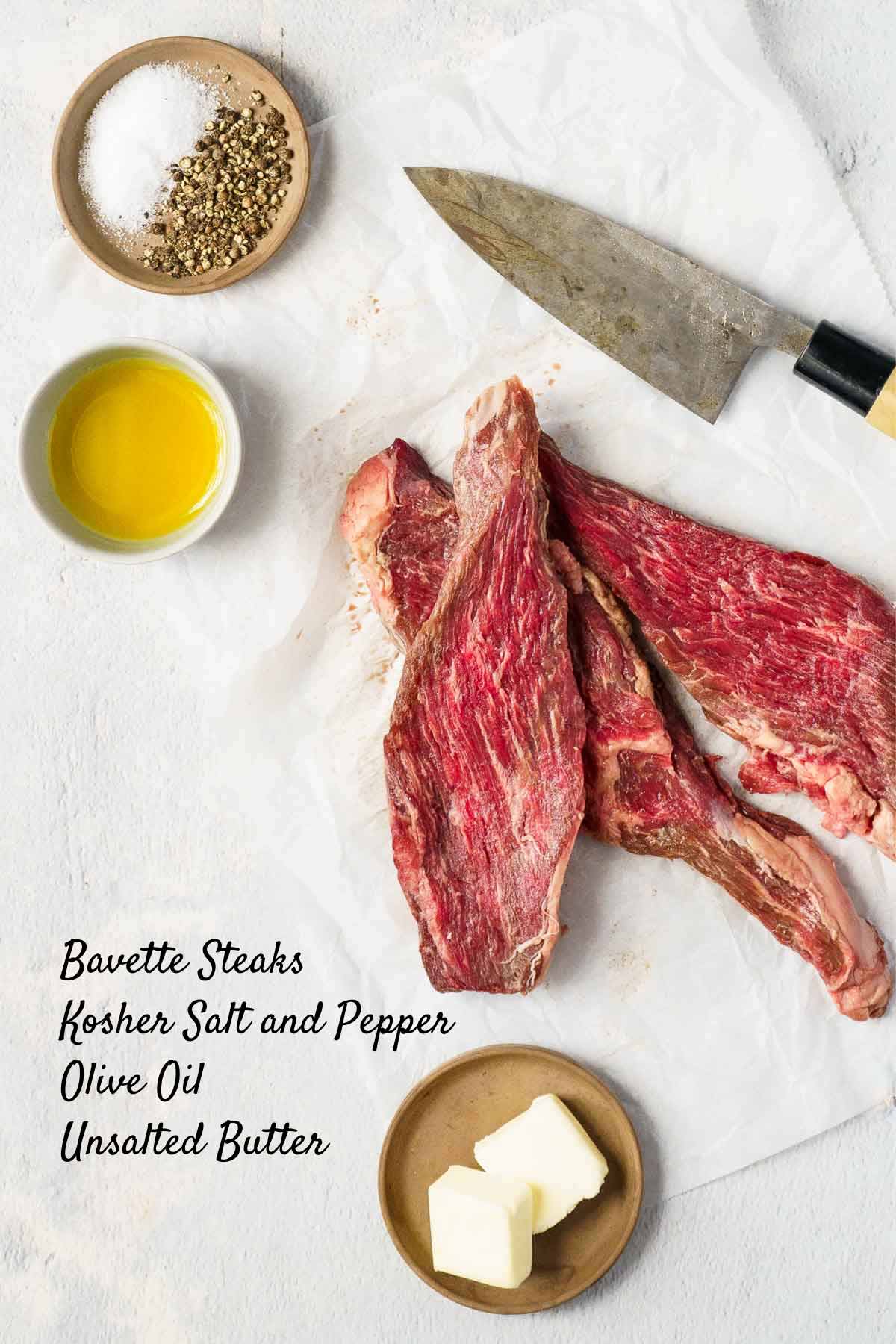
- Bavette steaks- Depending on what the butcher has you may get one large bavette or several smaller pieces.
- Kosher Salt and Pepper
- Olive Oil
- Unsalted Butter
Mixing the butter and olive oil together prevents the butter from burning while giving the steak a delicious flavor.
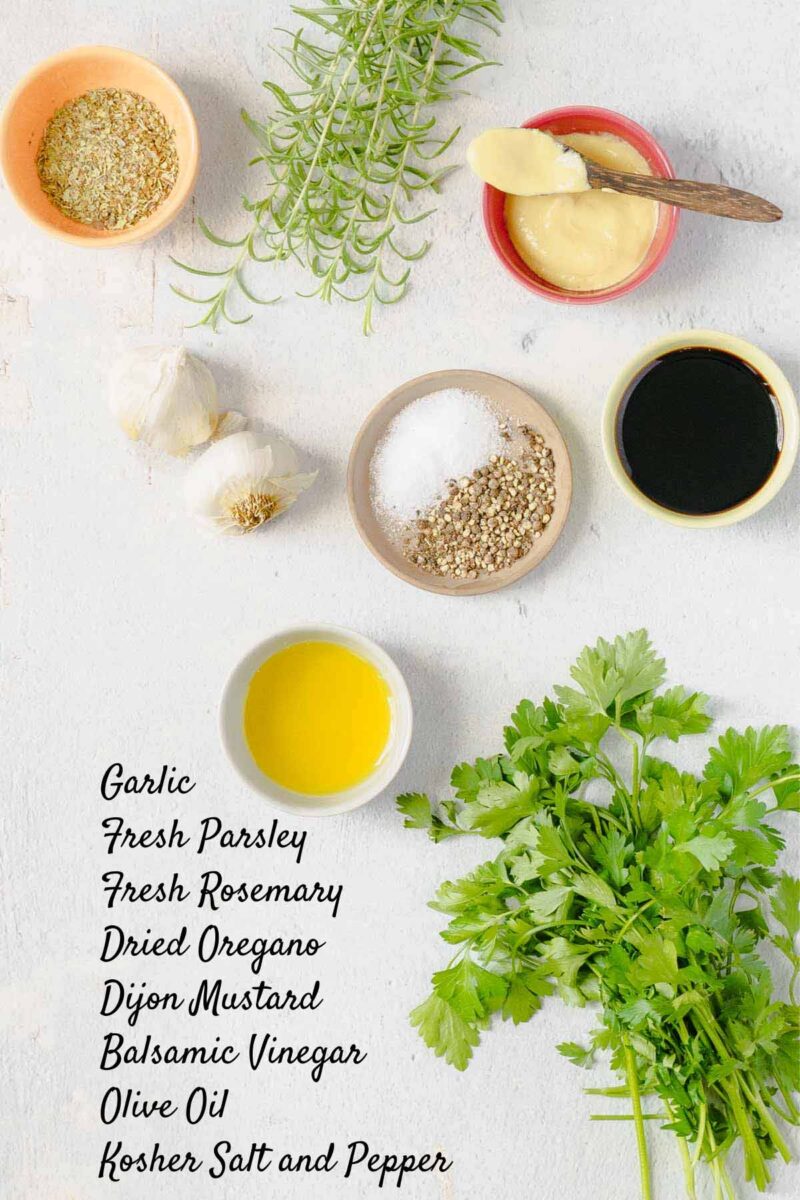
Balsamic Sauce and Marinade
- Garlic
- Fresh Parsley
- Fresh Rosemary
- Dried Oregano
- Dijon Mustard
- Balsamic Vinegar
- Olive Oil
- Kosher Salt and Pepper
See the recipe card for quantities.
⏲️How to Cook a Bavette Steak
Because sirloin bavettes have a distinctive grain and fine texture using our simple marinade and a cast-iron skillet (or other heavy-bottomed skillet) makes for the most tender and juicy steak. Let's get started!
Step 1- Marinade
Place all the ingredients in a blender, or a small food processor, and blend until smooth. Remove the stems of the fresh herbs and roughly chop to ensure a smooth marinade.
I do not drizzle in the olive oil (as you do with a basil pesto), just throw the whole thing and blend it up.
Add the steaks to a freezer bag or glass dish. Reserve ¼ cup to a ½ cup of the marinade to use as a sauce and pour the remaining sauce over the steaks.
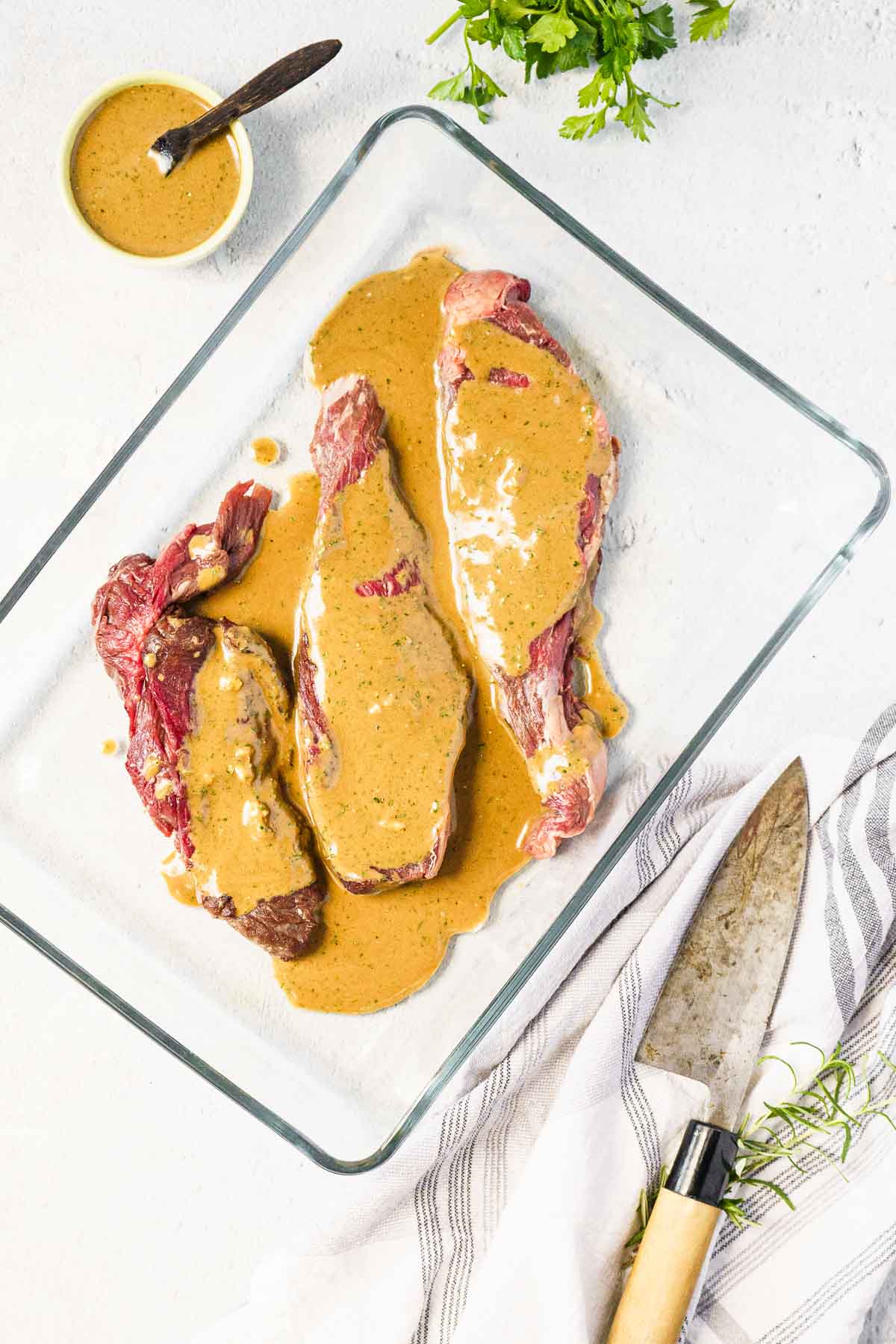
Toss to coat the steaks and then marinate for 1 hour. You can refrigerate the steaks overnight in the marinade if you wish. But be sure to refrigerator the reserved marinade in a sealed container.
Step 2- Cast Iron Sear
Remove the steaks from the marinade and discard the marinade. Shake or wipe off excess marinade from the steaks. Sprinkle with salt and pepper. Don't go overboard with the seasoning.
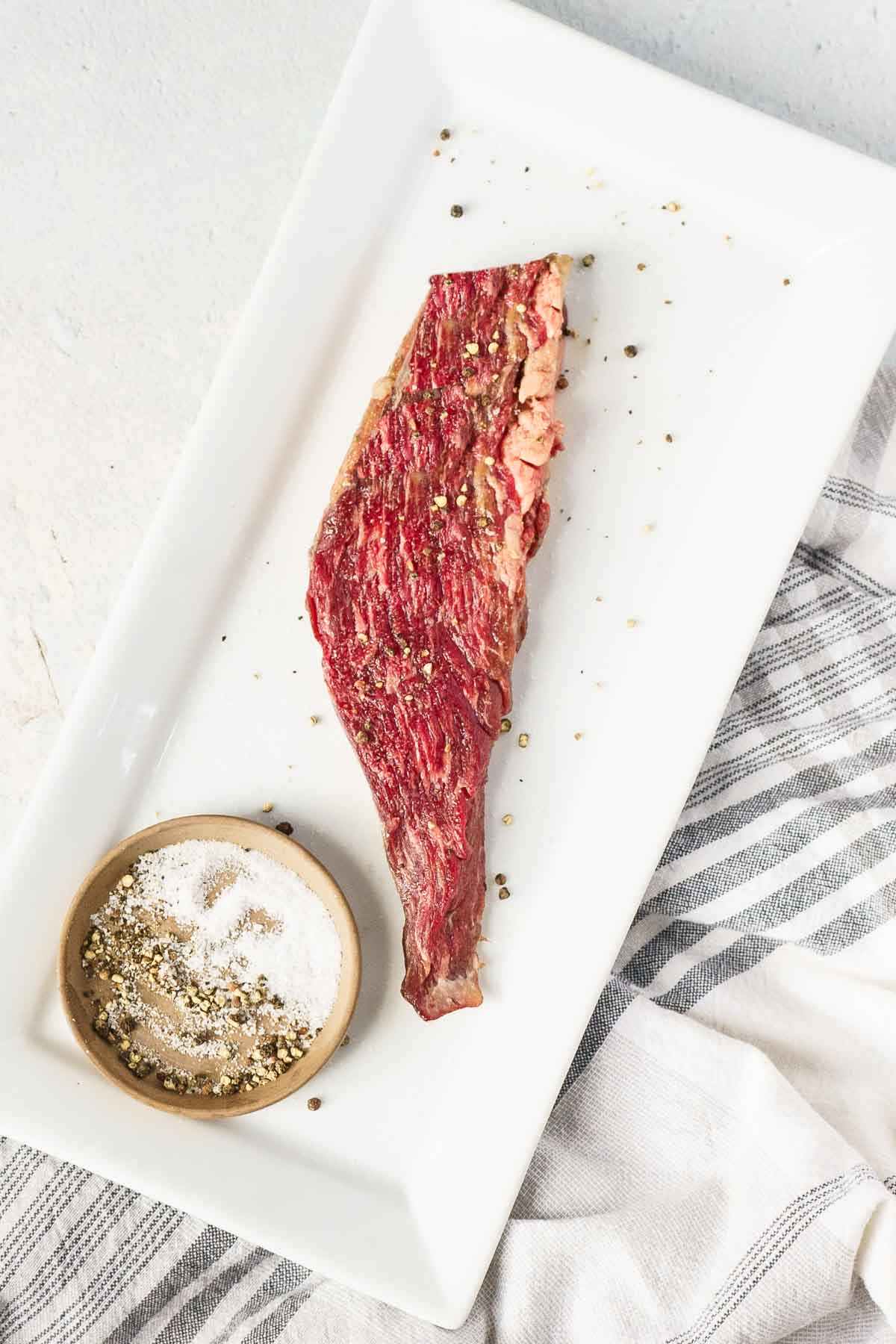
Place your cast-iron skillet over medium-high heat. Heat for 3 minutes before adding the butter and olive oil. Swirl the butter and oil around to combine and coat the bottom of the pan.
Add the steaks and cook for 3 to 4 minutes. Flip the steaks and cook for an additional 3 minutes. Use an instant-read thermometer to check for doneness.
Medium rare, or 135 F degrees, is our recommended doneness.
Step 3- How to Slice a Bavette Steak
Move the bavette steak from the cast iron skillet to a plate or cutting board and cover with foil. Rest the steaks for 5 to 10 minutes. This resting time lets the juices redistribute throughout the meat, so every bite is tender and juicy.
Using a very sharp Chef's knife cut across the grain into thin strips.
Serve the steak with the reserved sauce. Be sure to taste the sauce for seasoning and add extra salt and pepper if needed.
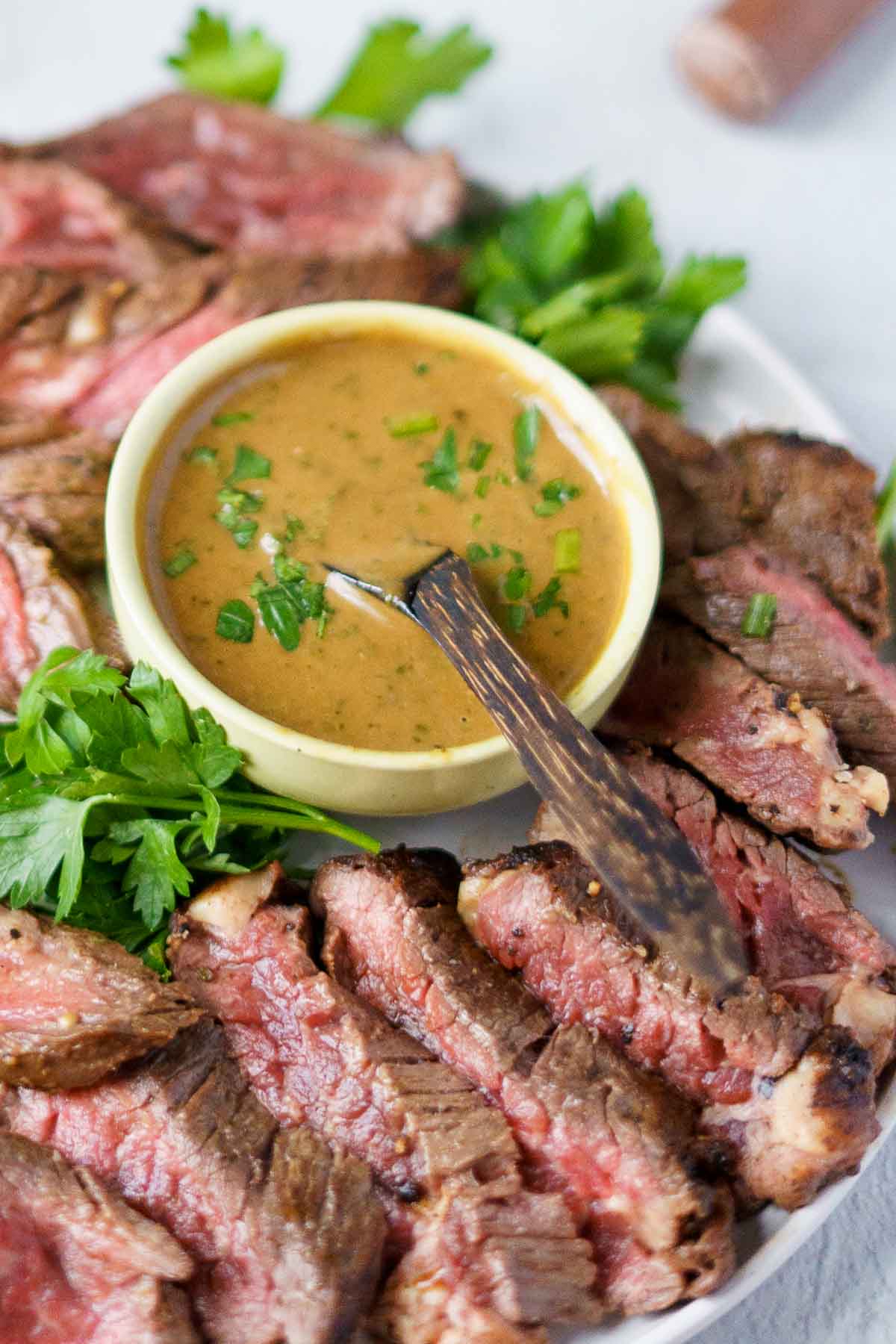
💭 Variations
While you can use any steak marinade you like on a bavette steak. The big difference or variation is in how your cook the steak. Grilling is our second favorite method (or our favorite when it is hot out).
Grilling a Bavette Steak
Marinated the steaks in the same manner, shaking off the excess. Lightly dry the steaks with a paper towel before sprinkling both sides of the steaks with salt and pepper.
To sear the steaks, we are going to use a direct heat method. You can use a charcoal or gas grill. Bring your grill to 400 to 450 F degrees.
Place the steaks on the grill over direct heat. Cook for 4 minutes before flipping. Cook another 3 to 4 minutes medium-rare. For medium steaks, move to indirect heat for an additional 3 to 4 minutes.
Let the steaks rest for 5 minutes before slicing against the grain. Serve with the remaining sauce in a small bowl.
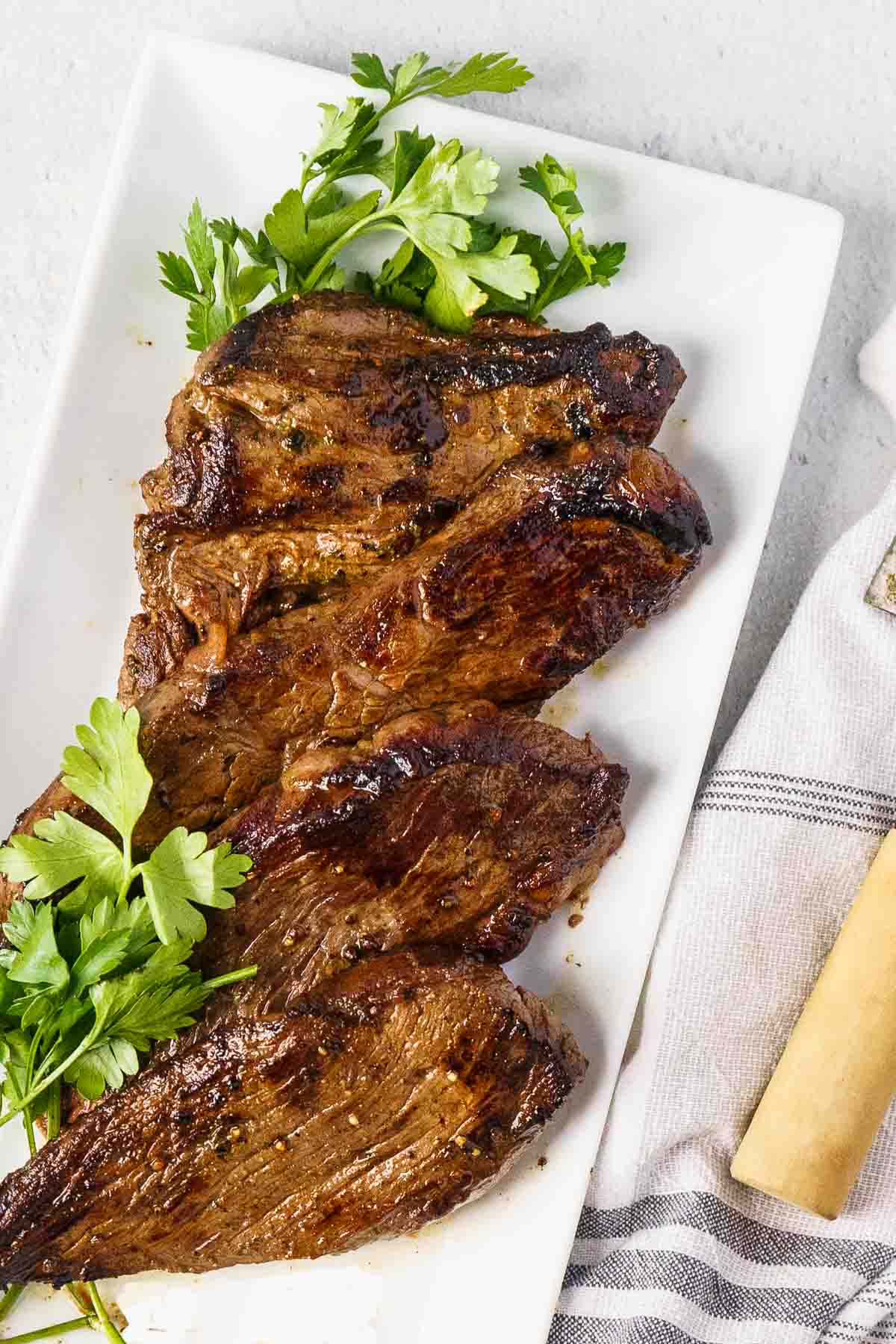
🥗What to Serve with Bavette Steak
During the Fall and Winter months, I crave hearty side dishes like parmesan and herb-baked rutabaga, baked mushrooms with balsamic, and lemon-roasted potatoes with feta.
But during the warm months of the year, I prefer vibrant side dishes like this spicy coleslaw recipe, easy tomato pie, or a sweet potato salad.
And no matter the season, I am obsessed with these green beans and garlic.
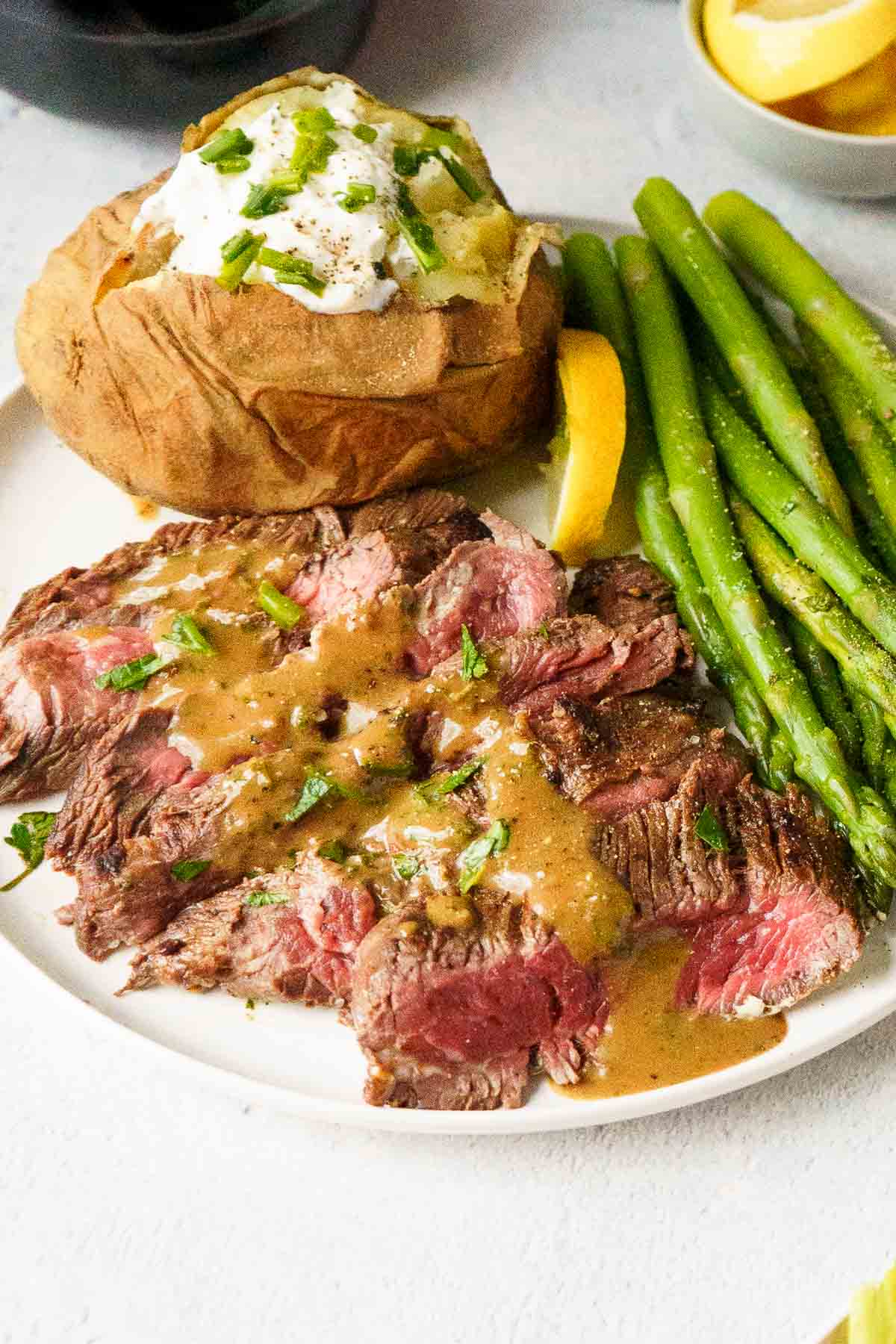
👩🏻🍳 Expert Tips
- Let your sirloin bavette steaks sit at room temperature for 30 minutes before cooking.
- If you want to add a finishing salt to your steak do so AFTER you have sliced it.
- If you marinate the steak overnight be sure to set our the reserved sauce for at least 30 minutes. The sauce should be served at room temperature.
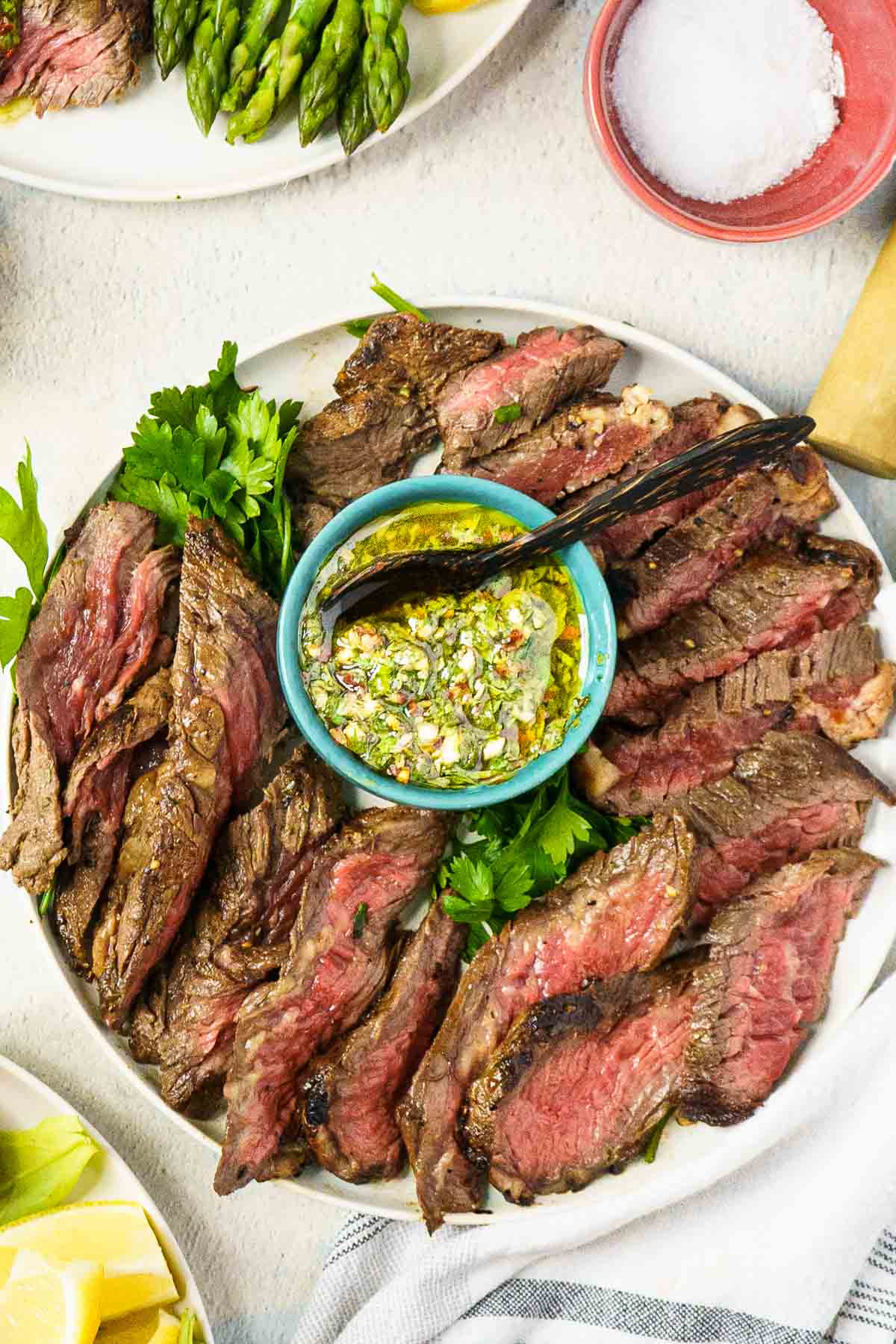
🌡️Storage and Food Safety
Raw steaks will keep for 3 to 5 days in the refrigerator. Storing it on a plate on the bottom shelf will reduce the chances of any drips contaminating other food.
To store leftover cooked bavettes, cool to room temperature before pacing a sealed container in the refrigerator. The leftover steak will keep for 3 days.
Leftovers can be eaten cold, on a salad, or reheat on the stovetop for use in wraps, stir fry, and more.
💬Frequently Asked Questions
Hanger steaks, flank steaks, and skirt steak all make good substitutions for bavette steaks.
First, allow your steak to rest under a foil tent for 5 minutes. Steaks should be sliced against the grain, which means against the direction that the muscle fibers run.
Did You Enjoy Making This Recipe? Please rate this recipe with ⭐⭐⭐⭐⭐ or leave a comment. It helps other wonderful people connect with my food.
📖 Recipe Card
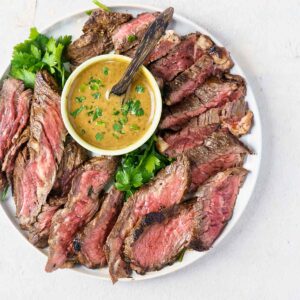
Bavette Steak
Ingredients
- 1 ½ pounds Bavette steak
- 1 ½ teaspoons kosher salt
- ¾ teaspoon black pepper
- 1 tablespoon olive oil
- 1 tablespoon unsalted butter
Balsamic Sauce and Marinade (optional)
- 2 garlic cloves
- 1 tablespoon fresh parsley roughly chopped
- 1 tablespoon fresh rosemary roughly chopped
- ½ tablespoon dried oregano
- 2 tablespoons Dijon mustard
- ½ cup balsamic vinegar
- 1 cup extra-virgin olive oil
- Kosher salt and pepper
Instructions
Balsamic Sauce and Marinade (optional)
- Combine all the ingredients in a blender. Process on high for 1 minute until creamy.2 garlic cloves, 1 tablespoon fresh parsley, 1 tablespoon fresh rosemary, ½ tablespoon dried oregano, 2 tablespoons Dijon mustard, ½ cup balsamic vinegar, 1 cup extra-virgin olive oil
- Add the meat to a freezer bag and pour all but ¼ cup of the sauce into the bag. Seal the bag and shake to coat. Marinade for at least 1 hour, up to overnight.1 ½ pounds Bavette steak
- Season the remaining sauce lightly with salt and pepper. Reserve for serving over the steak.Kosher salt and pepper
How to Cook a Bavette Steak- Cast Iron Method
- Remove the steak from the marinade. Shake off any excess. Salt and pepper both sides of the steak(s).1 ½ pounds Bavette steak, ¾ teaspoon black pepper, 1 ½ teaspoons kosher salt
- Heat the olive oil and butter in a cast iron skillet over medium high heat. Be sure to turn your vent hood on! Add the steaks and cook for 3 to 4 minutes per side for medium rare. Or cook longer to your desired doneness.1 tablespoon olive oil, 1 tablespoon unsalted butter
- Let the steaks rest for 5 minutes before slice. Serve with the remaining sauce,
How to Cook a Bavette Steak- Grill Method
- Remove the steak from the marinade. Shake off any excess. Salt and pepper both sides of the steak(s).
- Set up your grill for direct heat, between 400 and 450 degrees. Place the steaks on the grill and grill for 4 minutes per side, flipping only once for medium-rare. For medium steaks, move to indirect heat for an additional 3 to 4 minutes.
- Let the steaks rest for 5 minutes before slice. Serve with the remaining sauce.
Video
Notes
- Flank steak and hanger steaks make the best substitutes for bavettes.
- Rare (cool red center)- 125 F degrees
- Medium Rare (warm red center)- 135 F degrees
- Medium (warm pink center)- 145 F degrees
- Medium Well (slightly pink center)-150 F degrees
- Well Done (little to no pink)- 160F degrees
Nutrition
Article Resources & Reference
- Certified Angus Beef - Temperature Recommendations
- Cattleman's Beef Board- All About Bavette Steak Cuts




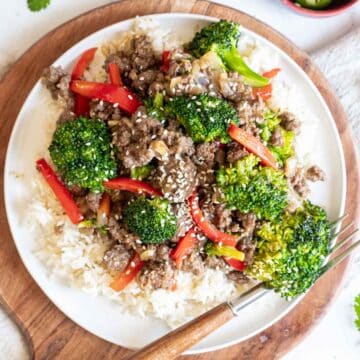
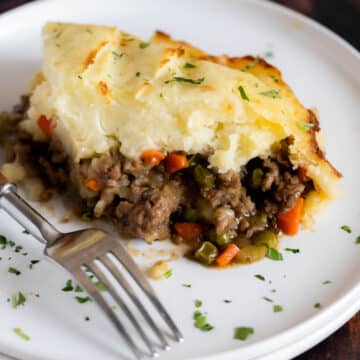
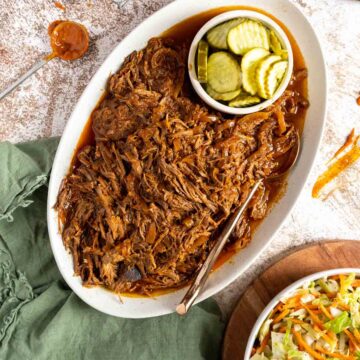
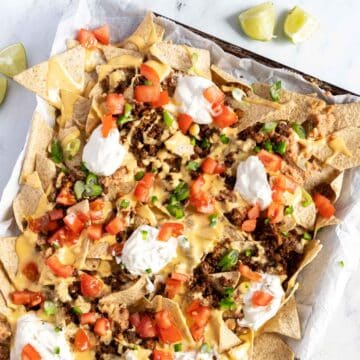
Pam says
We love this steak recipe. I sauté pears in butter add some brown sugar to glaze and add some walnuts. So delicious over a lettuce salad. Add Gorgonzola cheese.
Yummy
Jen Wooster says
Thanks for the feedback. So glad you like it!